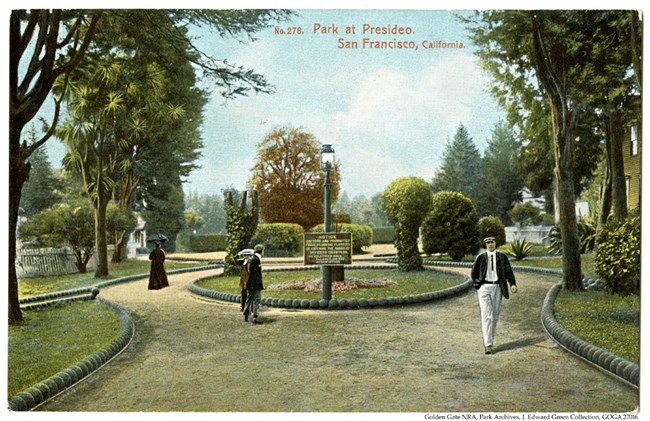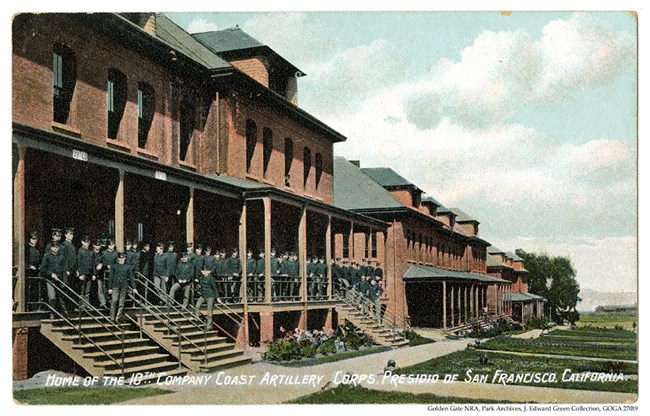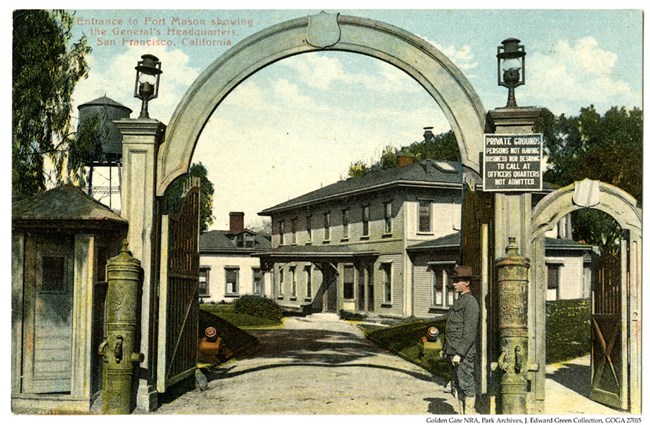
Golden Gate NRA, Park Archives, J. Edward Green Collection, GOGA 27016 J. Edward Green was a curator for the Presidio Army Museum. As with other employees of the museum, Green was an avid student of history and a dedicated collector of historical ephemera. He devoted a significant amount of time to the museum, and donated much of his collected material to the U.S. Army. Featured in this exhibition are his collection of postcards which pertain to the Presidio of San Francisco and Fort Mason. 
Golden Gate NRA, Park Archives, J. Edward Green Collection, GOGA 27012 
Golden Gate NRA, Park Archives, J. Edward Green Collection, GOGA 27019 One featured postcard of the Officers' Club at the Presidio of San Francisco is addressed to Sophie DeLa Nux, the daughter of a Honolulu bookkeeper who was connected to French nobility. The Officers' Club in the Presidio of San Francisco is one of the oldest buildings in San Francisco. Originally built of adobe in the 1790s by Spanish settlers, it was remodeled around 1847 by the U.S. Army and since then has been continually used by the military and now the National Park Service. With funding from the Works Progress Administration (WPA), the building underwent its second renovation during the 1930s that incorporated Mission Revival stylistic elements which have been continued in subsequent additions and renovations. Commonly known as "Infantry Row," the Montgomery Street Barracks were constructed along the Presidio's Main Parade Ground in the 1890s to accommodate an influx of soldiers after the closure of a multitude of frontier forts. Each barracks housed a company of 110 soldiers and followed identical floor schemes with the recreation room, mess hall, and the kitchen on the first floor and sleeping quarters on the two upper floors. 
Golden Gate NRA, Park Archives, J. Edward Green Collection, GOGA 27014 
Golden Gate NRA, Park Archives, J. Edward Green Collection, GOGA 27015 Letterman General Hospital, named for Major Jonathan Letterman, medical director for the Army of the Potomac, was constructed to address the medical needs of a post overwhelmed by troops encamped at the Presidio of San Francisco in preparation for embarkation to the Spanish American War. Designed by W.H. Wilcox of San Francisco, the U.S. Army General Hospital was completed in 1902 with a capacity of 300 beds and ten wards connected to administrative buildings by covered corridors. Innovative for the period, the hospital featured an intercom, x-ray machines, and in 1901, employment of the first group of women to emerge from the newly created Army Nurse Corps. In 1850, President Millard Fillmore claimed Punta de San Jose or Black Point (now known as Fort Mason) for use as a military reservation. However, the U.S. Army did not formally occupy the land until 1863. Since the land was designated on paper only, settlers in San Francisco, including John C. Fremont, unwittingly built homes on the government's land. Fearing a Confederate naval attack on San Francisco during the Civil War, the military returned to Black Point and evicted what it considered squatters, demolishing all structures except for one built by George Brooks, editor of the Golden Era. In 1865, the house was enlarged to accommodate Major General Henry W. Halleck who had taken command of the Military Division of the Pacific. When Major General Irwin McDowell took command of the Department of California in 1876, he requested larger facilities in order to entertain visiting dignitaries and San Francisco society. The house was moved north of its original site to serve as quarters for commanding officers on post, except for the kitchen and its left wing which were incorporated into the new structure. Since that time, the building has served as the residence for such notable figures as General Frederick Funston, General Arthur MacArthur (father of General Douglas MacArthur), Major General Hunter Liggett, and Adolphus W. Greely of Arctic fame, to name a few; and has entertained Presidents Ulysses S. Grant (1879) and Rutherford B. Hayes (1880). The J. Edward Green Postcard Collection was donated to the Presidio Army Museum over a number of years through the 1970s and 1980s. In addition, Green's expansive collection includes artifacts from local Native Americans, and items which pertain to the military presence in San Francisco, ranging in date from the Civil War to World War II. For more information: Montgomery Street Barracks The Alameda Letterman Army Hospital Fort Mason |
Last updated: February 28, 2015
